Blog
Dien Bien Ultimate Travel Guide for Tourists - Explore Real Asia

Please log in to continue

Dien Bien Ultimate Travel Guide for Tourists - Explore Real Asia
April 26, 2021
Famous for the battle of Điện Biên Phủ with the defeat of France in 1954, today Dien Bien has become a favorite destination for tourists all over the country. Tourist destinations in Dien Bien are diverse in forms, suitable for many different groups of travelers.
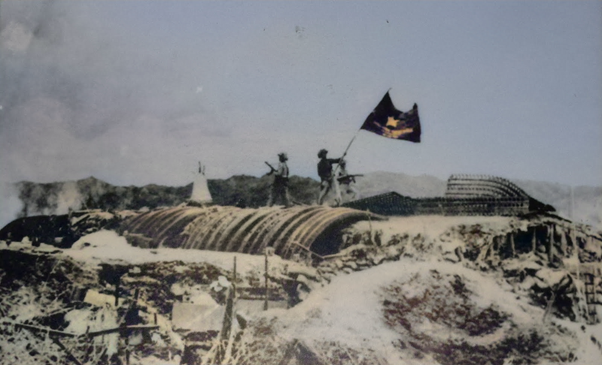
Dien Bien attracts the most tourists every year for the annual Dien Bien Phu victory anniversary
If you want to climb A Pa Chai, you should avoid the summer time because this is the Northwest rainy season with the hot summer heat, it will be very tiring and exhausting.
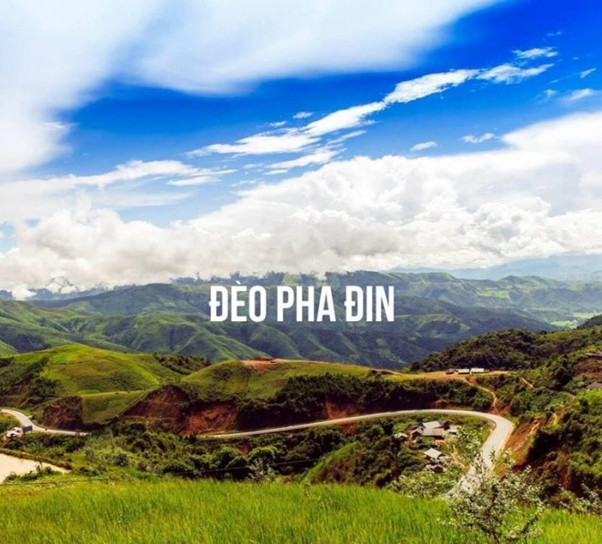
The road to Dien Bien will pass through Pha Din pass, one of the four great mountain passes in the North
Dien Bien is quite far from Hanoi (about 500km to Dien Bien Phu city), so it takes a long time to travel to Dien Bien. Currently, there are only 2 ways to get to Dien Bien: by road or by air.
From Hanoi to Dien Bien (Dien Bien Phu city) about 500km, with mountain pass terrain, it will take you about 10-12 hours to move here. The road running along NH6 goes through many beautiful places such as Mai Chau, Moc Chau, Son La ... that you can stop before coming here.
Road
Bed buses to Dien Bien run every day at My Dinh bus station, the car runs about 12-13 hours. Traveling in a bed car has another advantage of being able to attach a motorbike. If you do not like to go by car, you can also schedule a straight motorbike ride from Hanoi to Dien Bien, with a journey of about 500km you will take an entire day to go straight.
Vasco is currently the only airline that flies to Dien Bien (Photo - Du Nguyen)
Currently, Vietnam Airlines Vasco (a subsidiary of Vietnam Airlines) is the only airline operating the Hanoi - Dien Bien route, the aircraft used for this route is ATR 72 with a frequency of 2 flights a day. The flight time to Dien Bien is only about 1 hour, so it will be much more economical than going by car.
From Saigon, you need to take a flight to Hanoi and then choose the next transfer plan. If you plan to fly to Dien Bien, you can choose to fly from Saigon about 2 hours before the flight time and always rest at the airport before flying to Dien Bien. If you choose a vehicle, you can choose to fly in the afternoon and then in the evening to go to Dien Bien.
You can choose a motorbike rental option when traveling to Dien Bien, but for long trips like A Pa Chai, you should bring a motorbike from Hanoi to be more active (Photo - Cungphuot.info )
As a quite famous tourist destination, Dien Bien is typically a place that attracts a large number of older tourists visiting the Dien Bien Phu relic, so the means of travel in Dien Bien are mainly taxis. There are a number of companies that started opening motorbike rental services in Dien Bien, but not many, you can refer to the article below.
With a large and stretched area, the districts are very far apart, but the system of accommodation facilities in Dien Bien is quite complete. All districts have hotels and motels to serve tourists on the road to explore Dien Bien. Particularly in Dien Bien Phu City, there are nearly 100 accommodation establishments with all types of hotels, motels, and homestays that can welcome thousands of tourists simultaneously.
Please note, if you intend to travel to Dien Bien at the time of 7-5 every year, always remember to book a hotel early 1-2 months in advance. On this occasion, every year, there is usually a victory celebration in Dien Bien Phu, delegations from all over and often rent rooms in large numbers so they are always in a state of fire.
As a northwest highland province with many unique cultural tourism products, guests coming to Dien Bien can choose to relax in the tourist villages, often there are always many homestays of local people. Phuong is combined with tourism, turning into accommodation for travelers in need.
Dien Bien Phu battlefield relic area is a complex of historical relics recording the victories of the Vietnamese army and people in the heroic resistance against the invading French colonialists. The outstanding monuments of the old Dien Bien battlefield are hills A1, C1, C2, D1, the Hong Cui, Him Lam base, the Doc Lap hill, the Muong Thanh bridge and airport, the command cellar of General de Castries.
Victory monument Dien Bien Phu
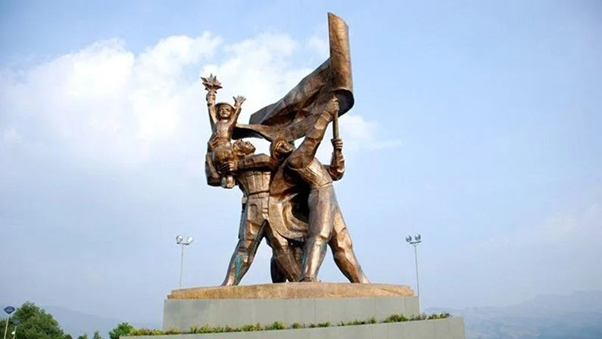
Victory monument Dien Bien Phu consists of 3 soldiers standing with their backs facing each other, lifting a Thai baby, the top is the winning flag. The statue is 16.6m high, made of brass, inside the reinforced concrete structure, weighing 220 tons. The pedestal is 3.6m high with reinforced concrete structure, the outside is covered with fine art stone, consisting of 3 rectangular diagonal floors. By sculptor Nguyen Hai - who was awarded the Ho Chi Minh Prize designed on the basis of his statue of Dien Bien Phu in the 1960s (1960-1965).
Victory monument Dien Bien Phu is located on D1 hill located in the center of Dien Bien Phu city - Dien Bien province. Based on the consultation of General Vo Nguyen Giap and the implementation of a survey plan, the Institute of Urban and Rural Planning (the Ministry of Construction) has proposed to select the location of D1 hill. Located in the center of the relic, about 50m high compared to Muong Thanh field, this is the place that the whole town area can see ...
On February 23, 2004, the monument "Victory at Dien Bien" was divided into 12 parts and transported from Nam Dinh to Dien Bien city by 11 super-heavy trailer trucks.
Hill A1
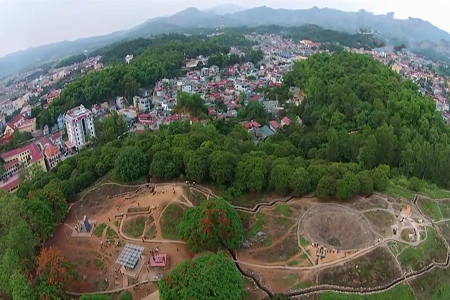
The view from above of hill A1
Hill A1 located in Muong Thanh ward, Dien Bien Phu city, Dien Bien province, is the most important base in the French colonial base group in Dien Bien Phu. Hill A1 is located in the Northwest - Southeast direction, including 2 peaks: the Northwest is over 490m high and the Southeast is 493m higher. A1 is the symbol that the Vietnamese army gave to the hill. On the morning of May 7, 1954 the Vietnamese army captured hill A1.
Currently, at the top of the northwestern hill of A1 hill, there is a monument built in the style of "Tam Son", in the middle is high, the sides are low and all have the shape of the roof. In the front is a censer, in the middle is a stele, the flag badge, a red circular background with yellow stars, surrounded by a circle of flowers.
Next to the monument is the corpse of one of two 18-ton tanks that Quan Ba Hécvée brought up from the center of Muong Thanh to attack the Vietnamese army. Another important relic is the funnel-shaped hole as big as a shallow "communal pond". That was the traces of the explosion of a thousand-pound explosion of our army that our soldiers often called "digging tunnels to cure tunnels", curing the whole tunnel, including the fortress of enemy fortresses.
Martyrs Cemetery at A1 Hill
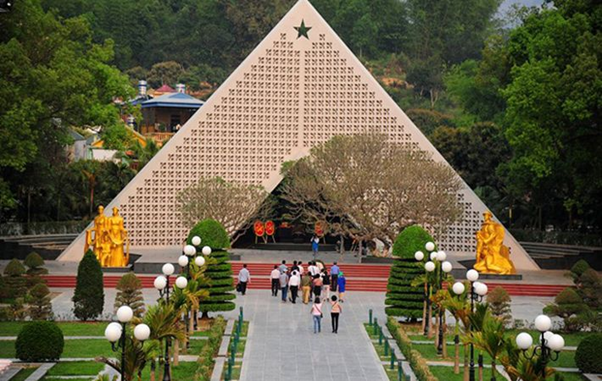
Martyrs' cemetery Dien Bien Phu on hill A1
Martyrs Cemetery (A1), located a few hundred meters south of the historic site of hill A1 (Dien Bien Phu city), was built in 1958.
There are 644 tombs of military cadres and soldiers who sacrificed heroically in the Dien Bien Phu campaign, mostly unknown graves, only 4 graves named heroic martyrs: To Vinh Dien, Phan Dinh Giot, Cu Van Dan, Tran Can. Cemetery space is very quiet, fresh air, green, clean and a beautiful environment. Every day, the cemetery is open from morning to evening to welcome visitors from domestic and international provinces.
de Castries tunnel

The Command Tunnel at Dien Bien Phu
General de Castries's command tunnel is located in the center of Dien Bien Phu stronghold, in Muong Thanh field, Dien Bien district, Dien Bien province. The structure and layout and arrangement of the cellar are still preserved. Around the cellar is a defensive fence with dense barbed wire and four tanks. The de Castries tunnel is 20m long and 8m wide, including four compartments for both living and working.
Operation Command Department Dien Bien Phu

The headquarters of the Dien Bien Phu campaign was located in the Muong Phang forest
The Dien Bien Phu campaign headquarters is located in a primeval forest in Muong Phang commune, Dien Bien district, Dien Bien province, 25 km east of Dien Bien Phu city. This is the working place of comrades Vo Nguyen Giap, Hoang Van Thai ... Near the headquarters, there is an observatory on the top of the mountain at an altitude of over 1,000m, from this observatory can cover activities and developments in Muong Thanh valley. Headquarters includes:
Museum Dien Bien Phu Victory
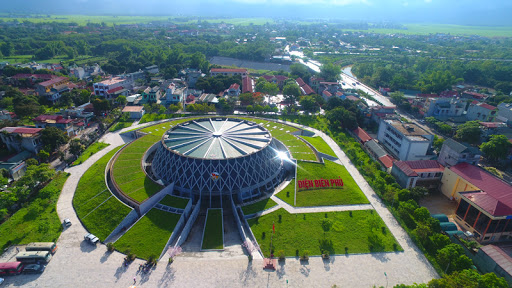
Victory Museum Dien Bien Phu
Dien Bien Museum is located at Street 1, Muong Thanh Ward, Dien Bien Phu City, Dien Bien Province. Dien Bien Phu Museum was built in 1984 on the occasion of the 30th anniversary of the historic Dien Bien Phu victory.
At the end of 2003, the Dien Bien Phu Museum renovated and reorganized the exhibition area. Up to now, the museum has 5 exhibition areas with 274 artifacts and 122 paintings according to the following themes:
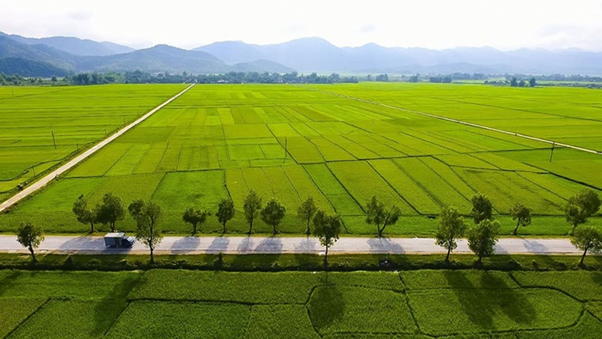
Standing at the top of the four largest fields in the Northwest according to the oral tradition "Nhat Thanh, Nhi Lo, Tam Than, Tu Tac", Muong Thanh fields running along the bank of Nam Rom river spread out like petals of bananas embracing di Historical record of the battle day. Either way, when coming to Muong Thanh, you will be surprised by the beautiful natural scenery and the richness of this place.
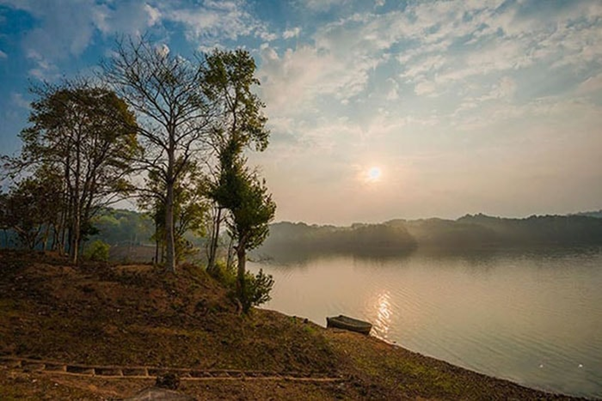
Pa Khoang Lake
Pa Khoang is located in Muong Phang commune, Dien Bien district, Dien Bien province, nearly 20km from Dien Bien Phu city, adjacent to Highway 279, linking Dien Bien Phu city with Dien Bien Phu - Muong Campaign Command Phang.
Pa Khoang lake is located in the middle of a natural area with majestic beauty, hidden in the clouds and the sky. In the winter, the mist falls, creating a fanciful landscape, looming in the distance are the rolling mountains, lovely house lines. In the summer, the atmosphere here is very comfortable with cool male winds. In the lake-bed area, there are Thai and Kho Mu ethnic groups that still retain the customs and characteristics of the Northwest ethnic groups ... If you have the opportunity to come to Dien Bien, take a little time to visit Pa Khoang lake to immerse yourself in nature.
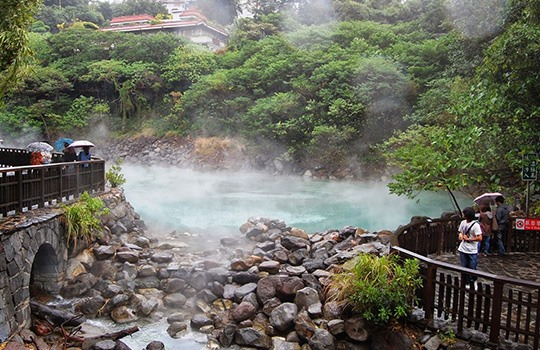
Hua Pe hot spring is located in Thanh Luong commune, Dien Bien district, 5km northwest of Dien Bien Phu city center. There is a large mineral water source with a regular temperature of about 60 ° C, next to the windy Pe Luong artificial lake all year round, forming the Dien Bien tourist destination with hot mineral water bath, is one of the An attractive eco-tourist destination with services such as relaxation and treatment is increasingly attracting tourists from near and far.
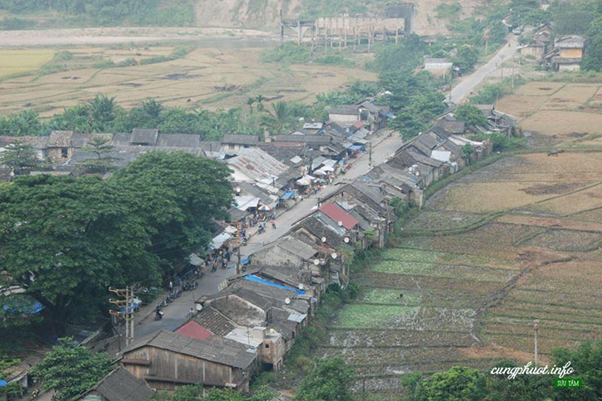
Old Muong Lay Town
Muong Lay is the northern gateway of Dien Bien province connecting with Lai Chau province, a land that has undergone many ups and downs in history. Today, Muong Lay, though there is still some pain from a past time due to the accidental destruction of nature, is changing the skin every day with the resettlement of Son La Hydropower.
In recent years, Muong Lay is striving in construction, development and has the appearance of a riverside city. Muong Lay is located on both sides of the Da River, connected by long bridges, underneath is a large hydroelectric lake bed that creates a charming picture. In the future, Muong Lay deserves to become the northern tourist center of Dien Bien province, an ideal destination for the Northwest Arc Travel journey for all of you.
Since the completion of the Son La hydropower project, the lake-bed level has risen about 213m and the area of about 100ha has created an extremely attractive ecotourism landscape for Muong Lay. is like a Ha Long on land.
With a cool and fresh climate of Northwestern mountains and forests, Muong Lay is the intersection of heaven and earth and mountains, past and present. The ferocious Da River in the past is now gentle, flat and immensely green, creating a feeling of comfort, lightness and harmony with nature, heaven and water.
Coming to Muong Lay, you should not miss the opportunity to travel by boat on the lake bed, to be immersed in the vast nature of rivers, mountains and forests, listen to colorful legendary stories about Da river Old violent giang. On the way to admire the lake bed, you can visit Lai Chau land to visit and learn about Deo Van Long mansion, visit the model of fish cage farming of indigenous people. This place is also always attractive for those who love to explore and are adventurous with activities such as fishing on the Da River, mountain climbing to explore Bac Ban Cave or walking through the forest to visit remote villages. Hidden by the cliff.

and a completely new Muong Lay Town after the Son La hydroelectricity accumulates water
Muong Lay not only attracts you by its poetic natural landscape, but also attracts people with the diverse and unique cultures of the 9 ethnic groups living in the country. Each ethnic group here has its own cultural identity, creating a very rich and diverse cultural picture with specific physical and intangible cultural values. The most typical cultural segment in Muong Lay is the culture of the White Thai people. Muong Lay is considered the capital of the White Thai people in Dien Bien. It is one of the cradles of the graceful hat dance, bottle dance, fan dance that has entered the human subconscious and poetry.
To better understand the cultural identity and life of the people here, you can visit traditional craft villages such as brocade weaving, making ethnic musical instruments in Na Lay Ward, manufacturing and processing wooden furniture. In Song Da ward, or knitting household appliances in Lay Nua commune. At night, stopping in the traditional stilt house, you can enjoy attractive specialties such as bitter bamboo shoots, flower bananas, fish salad, sausages, pa pepop, especially fish dishes. Tombs, fried fish and Da River shrimp are famous throughout the region. Mixing in the sweet aroma of corn wine, ecstatic glaze, you and the local people follow the rotation of the dance, releasing their souls to the sweet voices of Thai girls. You can also live together and live in families to learn the customs and habits of the people here and experience the feeling of being a "Thai ethnic group" once.
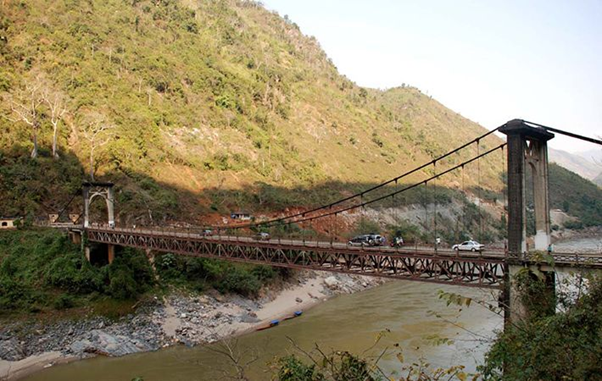
Before My Thuan Bridge was born, Hang Tom Bridge was the largest cable car bridge in Vietnam across the Da River, connecting Dien Bien with Lai Chau. To the Northwest, anyone wants to go back to Da Giang once to admire this bridge. Standing in the middle of the bridge, people are just a small dot in the middle of the water painting with soaring mountains, the river is deep, the waterfall is fierce, white clouds flying overhead ... Son La Hydropower comes into operation. high, devouring the legendary Hang Tom bridge, ending the mission of the first suspension bridge on the Da Giang stream for 40 years. Hang Tom Bridge used to be the largest cable-stayed bridge in Indochina with the pride of the Northwest, dubbed "Indochina First Bridge".
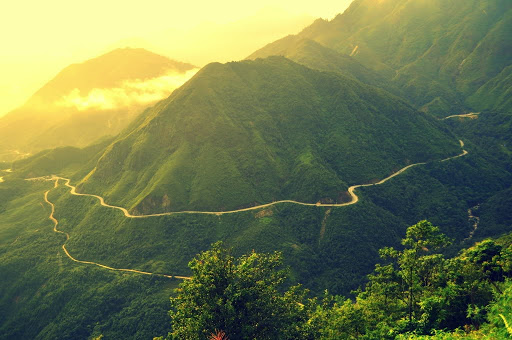
Pha Din or Doc Pha Din pass is a mountain pass with a length of 32 km located on Highway 6, part of Phoi Lai commune, Thuan Chau district, Son La province and part of Ta Tinh commune, Tuan Giao district, Dien Bien province. The starting point of the pass is 66 km west of Son La town and the end of the pass is about 84 km from Dien Bien city. This is also one of the Four Great Passes honored by the Pheo people, the remaining 3 are Ma Pi Leng, O Quy Ho and Khau Pha.
The name Pha Din pass originally originated from Thai, Phạ Đin, in which Pha means “heaven”, Din is “earth” meaning that this place is the junction between heaven and earth. The former Lai Chau (now Dien Bien) and Son La from the past still circulate the story of a discussion of trying to demarcate the boundaries of the two localities with a horse race over the slope of Pha Din. People and horses on both sides simultaneously depart from the two passes. The two heroes and two beasts have the same strength and will, so the distance they go to the meeting place on the pass is not much different. However, the part of Lai Chau is faster, so the pass belonging to Lai Chau is a bit longer than the part of Son La.
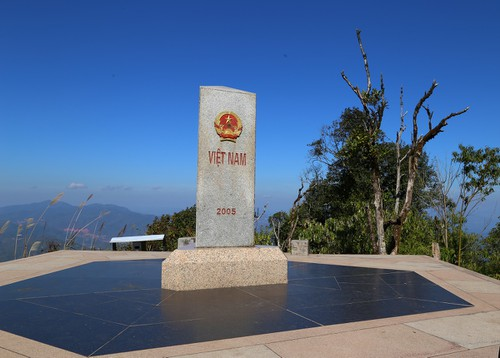
Landmark 0, the border between Vietnam - Laos - China is located at A Pa Chai, this is also the westernmost part of the country
In the four poles of Vietnam's territory, the westernmost pole of A Pa Chai is located on the top of Khoang La San, away from Ta Mieu village, the last village to the west of Sin Thau commune, Muong Nhe district, Dien Bien province 6 km forest road, Dien Bien is considered the most difficult point to conquer. The border landmark was built of marble with three faces facing three directions, each side engraved with the country name in its own national language and the national emblems of Vietnam, Laos and China.
To reach the land where the headland of the country is from Hanoi, you can take a Dien Bien bus (with a motorbike) up to Dien Bien Phu city and then go on to the center of Muong Nhe district. From here to Sin Thau about 70km. Finally, you need to walk about 10km from the Apachai border post to reach the destination.